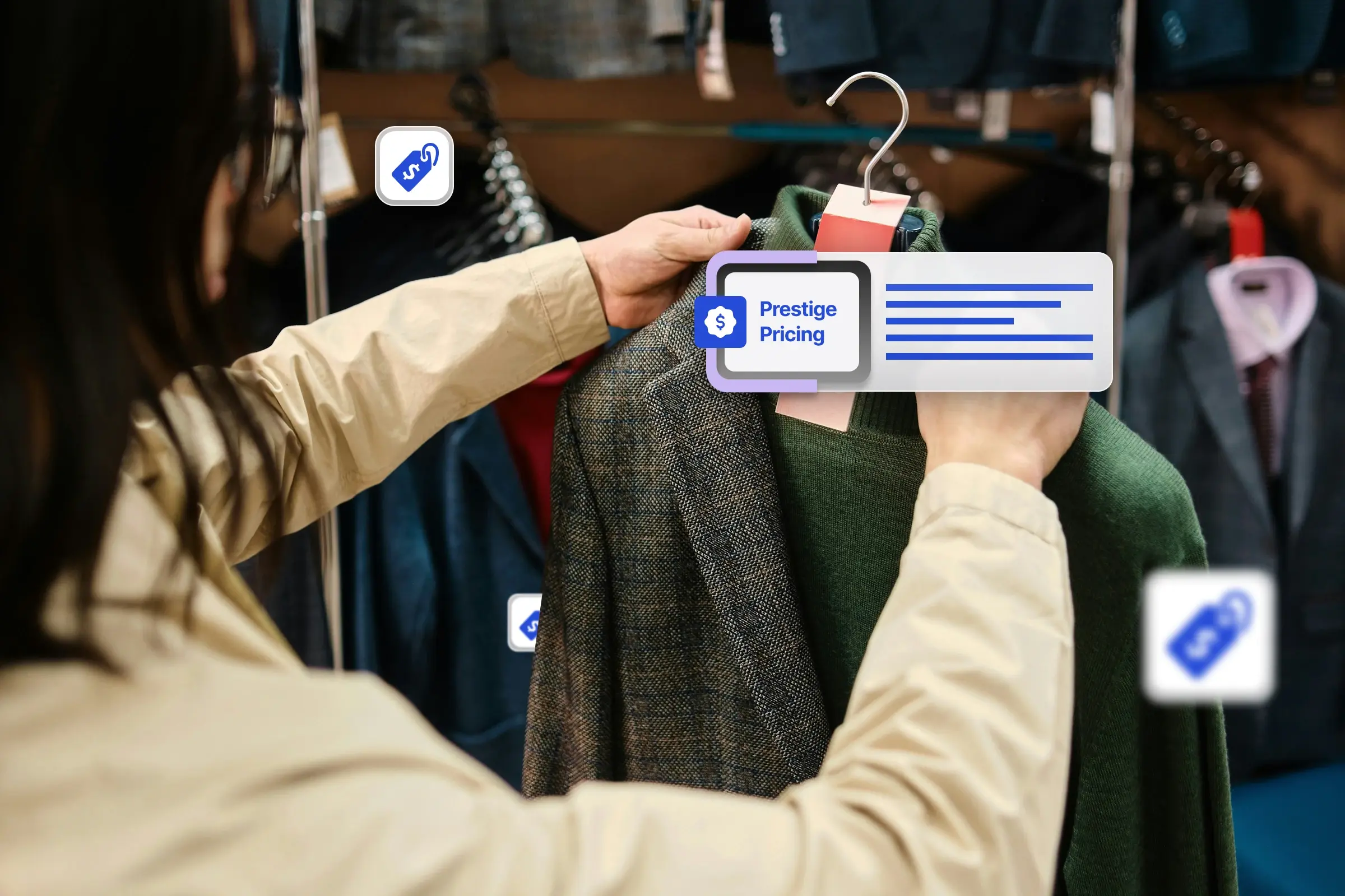What does your price say about your brand? Is it setting the right tone or simply following the market?
Prestige pricing is about much more than adding a premium price tag. It’s about shaping how your brand is perceived. A higher price shouldn’t just be a number—it should signal quality, exclusivity, and desirability. Get it right, and you elevate your brand. Get it wrong, and you risk losing the very customers you’re trying to attract.
The real question is: how do you use prestige pricing to position your brand for the future, while still appealing to the right audience?
This isn’t about making a deliberate choice to stand out. Let’s dig into how this strategy can help your brand grow and make a lasting impression.
What is Prestige Pricing?
Prestige pricing involves pricing a product higher than alternatives. The idea is to make the product appear exclusive, high-quality, and rare. The goal is not to have competitive pricing but to create a perception of superior value. It’s about making the price itself a statement.
The key to this strategy is psychology. Consumers often associate a higher price tag with signals that a product is made from superior materials or offers better performance. It’s about creating a sense of exclusivity, where the product feels special because it’s priced higher.
For this strategy to succeed, the product must back up the price. The price tag can’t be arbitrary. It must reflect the quality, experience, and value that meet the consumer’s expectations. If the product doesn’t meet those expectations, the strategy can fail. Consumers expect a premium experience when they pay a premium price.
Key elements of prestige pricing include:
- Quality: A higher price suggests a higher standard of craftsmanship or materials. Consumers expect top-tier performance or durability.
- Exclusivity: When a product is priced high, it often feels more limited or rare. People desire what is difficult to access or afford.
- Brand Identity: The price reflects the values of the brand. Luxury brands position themselves as symbols of success, style, and status.
Prestige pricing isn’t just about a higher price. It’s about crafting an experience that justifies that price. The product becomes more than just a commodity—it becomes a symbol of status, exclusivity, and quality. When done right, it elevates both the product and the brand, making them stand out in a crowded marketplace.
Prestige Pricing Examples
Prestige pricing plays out in many industries. Here are some practical use cases that show how businesses apply it:
- High-End Apparel Line – A fashion retailer launches a capsule collection priced significantly higher than its core range. The higher price signals limited availability, superior craftsmanship, and exclusivity, even though production costs aren’t drastically higher.
- Premium Electronics Model – A consumer electronics company releases a flagship product at a much higher price than its mid-tier options. The price communicates cutting-edge features and aspirational ownership, even though most buyers use only a fraction of the features.
- Luxury Auto Trim – An automaker introduces a special-edition trim with advanced features and elevated design details. By pricing it well above the standard models, the company creates an aura of status, appealing to customers who want exclusivity.
- Fine Dining Experience – A restaurant offers a chef’s tasting menu at a significantly higher price than à la carte options. The pricing itself becomes part of the experience, suggesting artistry, exclusivity, and indulgence.
- Personal Care and Beauty – A skincare company prices a “signature” product line above its standard range. Customers perceive the higher cost as proof of superior ingredients and effectiveness.
These examples illustrate how prestige pricing works best when the higher price reinforces a story of exclusivity, quality, and differentiation, beyond just the product itself.
Why Prestige Pricing Works?
Prestige pricing is effective because it taps into a deep-rooted psychological principle: people value what’s scarce and unique. When a product is priced high, it is automatically positioned as something rare or exceptional. The prestige pricing model doesn’t just sell a product; it sells an experience, a lifestyle, and an identity.
Here’s why it works:
- Higher prices trigger the “halo effect”, where people assume that if a product costs more, it must be of higher quality. Even when there is no visible difference in the product’s features, a premium price can elevate perceptions. This perception often leads to consumers believing they are getting something superior, even without concrete evidence.
- When consumers buy expensive items, they often feel a stronger sense of ownership. They don’t just purchase a product—they purchase the status and prestige that come with it. This emotional connection drives brand loyalty. The feeling of owning a rare, premium product often makes consumers more attached to the brand.
- Brands that employ prestige pricing are often perceived as leaders in their industry. A premium price signals to customers that the brand isn’t just part of the competition—it sets the standard. It gives the brand authority, positioning it as the go-to choice for those seeking the best, rather than just the most affordable.
- Price is a key tool for building the story around a product. Prestige pricing doesn’t just reflect the cost of production—it reflects the value and experience attached to the product. Consumers are drawn to the narrative that a higher price tag tells: a story of quality, craftsmanship, or even the legacy of the brand.
Despite its effectiveness, the prestige pricing strategy presents its challenges. The high price must be supported by the product and brand’s quality. If customers feel they aren’t getting the value they expected, the price will be seen as unjustifiable, which can quickly erode trust.
How to Implement & Use Prestige Pricing Strategies?
Implementing prestige pricing isn’t a matter of simply raising the price of your product. It’s about creating a seamless connection between price, quality, and brand perception. To do it successfully, every aspect of your brand needs to support the premium price point. Here’s how to implement this strategy effectively.
Define Your Brand’s Value Proposition
Before you set a high price, ensure your product or service offers something that justifies it. It’s not enough to just claim exclusivity or luxury; you must deliver on those promises. Focus on quality, innovation, or features that make your product stand out.
Your brand’s story is equally important. It must reflect a commitment to excellence and a clear differentiation from lower-priced alternatives. When consumers purchase your product, they’re buying a narrative, not just a physical item.
Create a Premium Customer Experience
The experience surrounding your product should match the premium price. From your customer service to the unboxing experience, every touchpoint should reinforce the idea of luxury.
Invest in high-quality product packaging, excellent customer support, and a seamless buying process. When your customers feel valued and receive high-quality service, the higher price feels more justified.
Emphasize Exclusivity
People want what they can’t have, which is why exclusivity is central to the success of prestige pricing. Create limited editions or position your product as a rare find in a crowded market. Scarcity drives demand, so limited availability can make a product more desirable.
For example, if you sell high-end fashion, releasing seasonal or capsule collections can create buzz and urgency. By limiting access, you enhance the product’s perceived value.
Leverage Brand Ambassadors or Influencers
Having trusted figures associated with your brand helps reinforce its prestige. Whether through high-profile endorsements or collaborations with influencers who align with your brand’s image, these partnerships make your product feel more exclusive.
Ensure the influencers or brand ambassadors you choose reflect the values of your brand. They should embody the exclusivity and high quality you are trying to project.
Ensure Consistent Messaging Across All Channels
For prestige pricing to be effective, every piece of communication, from marketing materials to your website, needs to consistently reflect the high-end nature of your product. Your messaging should align with the premium experience you’re offering.
This includes your visual identity, the language you use, and the tone of your marketing campaigns. Everything should reinforce that your product is a luxury item worth every penny.
Monitor and Adapt to Market Feedback
Once you implement prestige pricing, it’s essential to track how consumers respond. Are they perceiving the product as valuable and exclusive? Is the high price creating the desire you want? If the response isn’t as strong as expected, you may need to revisit the product’s quality or adjust your brand messaging.
Being open to feedback ensures your pricing strategy stays relevant and continues to meet customer expectations.
Build Long-Term Brand Loyalty
Implementing prestige pricing isn’t just about getting a premium price—it’s about building long-term value for both your brand and your customers. A premium product should deliver more than just a one-time sale. It should foster ongoing loyalty through exceptional experiences and consistent value.
Think of ways to keep your customers engaged, such as exclusive memberships, loyalty programs, or personalized services. The goal is to make them feel that being part of your brand is a privilege.
The Common Pitfalls of Prestige Pricing
Prestige pricing can be a powerful tool, but it’s not without its challenges. If not executed properly, it can backfire, damaging both your brand reputation and your sales. Let’s look at some of the pitfalls of prestige pricing.
Overpricing Without Justification
Raising prices without offering clear value can backfire. Customers expect premium products to deliver superior quality. Without this, they may feel deceived, damaging your brand’s trust.
Misunderstanding Your Audience
Prestige pricing works for a specific market. If you price too high for your target demographic, you risk alienating potential customers. Understand what your audience values before setting a premium price.
Failure to Align Price with Product and Experience
Your product must live up to the premium price. This includes quality, packaging, and customer service. A disconnect between price and product leads to dissatisfaction and lost loyalty.
Ignoring Perception
If your brand is not seen as premium, no amount of price increase will change that. Build a strong, aspirational brand image that matches the high price you’re setting.
Overexposure
Exclusivity drives desire. If you overproduce or overpromote, you can dilute the perception of rarity and luxury, undermining the prestige associated with your product.
Lack of Long-Term Loyalty
Prestige pricing can generate short-term success, but it’s crucial to foster long-term brand loyalty. Without ongoing value, customers may not return, and the price will seem unjustified.
Measuring the Success of Prestige Pricing
Measuring success goes beyond just tracking sales figures. It’s more about understanding how the price influences customer perception, brand positioning, and long-term loyalty. Here’s how you can evaluate the effectiveness of your strategy.
Track Profit, Not Just Volume
With prestige pricing, it’s not about selling more units. It’s about generating higher profit margins. Fewer sales can still mean greater success if the price is set appropriately, and your overall revenue increases.
Customer Feedback and Sentiment
Monitor feedback from your customers—whether it’s reviews, surveys, or social media comments. Are they valuing the exclusivity, quality, and experience of the product? Positive sentiment is a strong indicator that your pricing strategy resonates with your target audience.
Brand Perception and Market Positioning
Your brand should be seen as a leader in your market. Are customers viewing your brand as high-end and exclusive? If your brand is associated with luxury, you’re likely succeeding in positioning your product as premium.
Customer Retention and Loyalty
Track whether customers return for future purchases. Prestige pricing is effective when you foster loyalty and repeat business. If customers are willing to pay a premium price repeatedly, it signals strong value and satisfaction.
Market Penetration in High-End Segments
Success in the luxury market is not measured by mass-market appeal. Check if your product is performing well in premium or niche markets. This indicates your pricing is attracting the right audience—those who value exclusivity.
Is your prestige pricing strategy delivering the results you expected in terms of profits, customer loyalty, and brand perception?
Pros and Cons of Prestige Pricing
Prestige pricing can be a growth engine when executed well, but it comes with risks that demand discipline. Here’s a balanced view:
The Upside
- Stronger Margins – Premium pricing enables brands to earn more per unit, protecting profitability even at lower volumes.
- Market Differentiation – Customers associate higher prices with exclusivity, status, and price of ownership.
- Loyalty Beyond Logic – Once buyers align with the brand story, they often return, not for the lowest price, but for the experience.
- Insulation from Price Wars – Competing on value and perception means less exposure to constant discount battles.
The Trade-Offs
- Smaller Target Audience – High prices limit your market to those willing and able to pay.
- High Expectations – Premium buyers demand flawless quality, service, and consistency.
- Brand Reputation Risk – If the product or experience underdelivers, trust erodes quickly.
- Limited Pricing Flexibility – Frequent discounts or promotions can dilute the perception of exclusivity.
- Execution-Dependent – Success requires seamless alignment between product quality, storytelling, and customer experience.
Final Thoughts
Prestige pricing directly drives your brand’s market position and profitability. To succeed, your price must reflect real quality, exclusivity, and consistent customer experience—no shortcuts. When aligned perfectly, prestige pricing elevates your brand above the competition and builds lasting loyalty.
We specialize in implementing data-backed prestige pricing strategies that deliver measurable growth and clear brand differentiation. If your goal is to position your brand as a premium leader and protect your margins without guesswork, Impact Analytics PriceSmart can help. Talk to our experts and get started today!
Frequently Asked Questions
How does prestige pricing affect customer perception beyond just price?
Prestige pricing shapes customer perception by signaling superior craftsmanship, exclusivity, and status. It creates an emotional connection where consumers see the product as a symbol of success and quality, driving loyalty that transcends typical purchasing decisions.
What risks do brands face when implementing prestige pricing without adequate product support?
If quality, experience, or exclusivity don’t match the premium price, customers feel deceived, damaging trust and brand reputation. This mismatch leads to lost sales and negative word-of-mouth, undermining long-term brand value and pricing power.
How can brands balance exclusivity and accessibility in a prestige pricing model?
Successful brands use limited editions, tiered product lines, or controlled distribution to maintain exclusivity without alienating aspirational customers. This balance ensures prestige is preserved while allowing wider audience engagement at different price points.
How do data and scenario analysis enhance prestige pricing effectiveness?
Using data on demand elasticity, competitor pricing, and customer feedback allows brands to set prices that protect margins without sacrificing exclusivity. Scenario simulations help predict impacts, enabling confident decisions that align pricing with real market dynamics.





